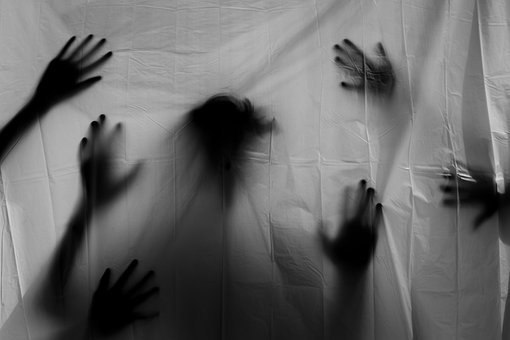Traditionally, women in horror films have been relegated to submissive background roles. From being nameless pairs of breasts slated for an erotic murder to enduring sexualized violence, women in horror are rarely permitted their agency — if they survive. Recently, these depictions are changing. Women are becoming main characters in horror, the ones who go through hell and back or even do the sexy slashing themselves. To see women subverting long-standing tropes of the genre is exhilarating. Just in time for International Women’s Month, here are some of my favorite horror films spotlighting women.
“Ginger Snaps” (2000)
Ginger Fitzgerald (Katharine Isabelle) and her sister Brigitte (Emily Perkins) are just two edgy goth teens trying to stay cool in their lazy suburb. On the night of Ginger’s first period, she’s attacked by a werewolf that’s been terrorizing the town. The girls’ lives become much more complicated than dealing with popular kids: Brigitte must help Ginger hide symptoms of lycanthropy — increased hunger, mood swings, even a tail — while seeking a cure.
“Ginger Snaps” is a landmark in feminine horror that’s still relevant today. “A girl can only be a slut, a bitch, a tease or the virgin next door,” Ginger explains to Brigitte, attempting to justify her strange behavior. The film is a must-watch for the feminist analyst; it explores sisterhood, misogyny and the body horror of growing up, all through the lens of campy lycanthropy.
“Jennifer’s Body” (2009)
Needy Lesnicki (Amanda Seyfried) is an average, quiet girl and her best friend Jennifer Check (Megan Fox) is the hottest, most popular girl in school, making them an odd pair. After a near-death experience, Jennifer begins acting strange. She’s been possessed by a succubus — a flesh-eating sex demon — due to a satanic sacrifice gone wrong. Jennifer’s killers believed she was a virgin, but since she wasn’t, they mistakenly invited a succubus into her body. Needy attempts to stop Jennifer from eating every teenage boy in their town while combating her repressed feelings for Jennifer.
“Jennifer’s Body” is explicitly about female sexuality. Jennifer makes frequent commentary on misogyny, even after she becomes a boy-eating demon. Moments between the two friends, before and after Jennifer’s possession, point toward their unspoken mutual feelings. An early scene even features a student calling Needy “lesbi-gay” when she waves at Jennifer during a pep rally, disregarding that Jennifer waves back, equally enthusiastic. While it’s unclear if the succubus can be expelled from Jennifer’s body, or if the real Jennifer is still even in there, Needy persists in stopping the demon. She loves Jennifer enough to spare her loved ones the horrific reality of the succubus and preserve her best friend’s memory.
“Excision” (2012)
Possibly the most tragic horror movie I’ve ever seen, “Excision” is now one of my top coming-of-age films. Pauline (AnnaLynne McCord) is a high school senior who dreams of becoming a surgeon. Like many eldest daughters, she desperately desires her mother’s (Traci Lords) approval and loves her little sister more than life itself. By day, Pauline is a nuisance to her classmates and mother. By night, she’s wracked with bloodsoaked, erotic dreams in her own personal operating room, and her bullies are the patients. She knows her psychosexual surgical suite fantasies are wrong — and though she seeks help — no one in her sunny suburb listens, not her pushover father, overbearing mother, teachers nor the town’s reverend (John Waters). McCord’s performance is award-worthy; I cried during scenes with Pauline and her mother that ultimately build up to the heart-wrenching ending. Pauline, though disturbed, is simply a frightened girl trying to mature. The fact that she pleads for help and is ignored until it’s too late is perhaps the most horrific part of all.
“Carrie” (1976)
Carrie White (Sissy Spacek) is a lonely outcast who’s teased by her peers. Like Ginger Fitzgerald, Carrie’s story begins with her first period. Terrified, she seeks the aid of the girls in her gym class, only to be brutally assaulted with pads, tampons and taunts. This is when Carrie’s telekinetic powers manifest.
While I wanted to love Carrie and her ultimate revenge on her horrible classmates and mother (Piper Laurie), I couldn’t ignore the disgustingly obvious sexism with which director Brian De Palma handled the film. Tracking shots of Carrie, her gym class and gym teacher Miss Collins (Betty Buckley), are deliberately eroticized; a later parallel scene of Carrie isn’t given the same treatment, only emphasizing the earlier sexualization. Carrie’s mother is also difficult to stomach. Laurie seemed to affect an Old Southern accent for the character, which was nearly comical for a film set in Maine. Despite being dated, “Carrie” arguably paved the way for most of the films here, and should be paid its dues for that arduous task.
Copy Chief | Jada Chambers (she/her, 23C) is from Southaven, Mississippi, majoring in art history and classical civilizations. When she isn’t copy editing, you can find her translating ancient Latin or watching cheesy old horror flicks.






